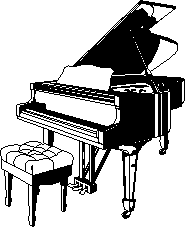Another Music / Midi Site
MIDI = Music Instruments Digital Interface
Automated Music is much older than (Computer) Midi Music.
Especially here in The Netherlands, we have a great
tradition in this respect.
Maybe the oldest examples of Automated
music are the chimes.
Chimes are already found in Europe
in the 13th century. They are
typically associated with church towers.
Another example of Automated Music is
the music box. They come in two
flavors: the music box with
a cylinder and the music box with (iron) disks.
Music boxes of this
kind were manufactured already at the end of the 18th century, by Swiss watch
makers. But you can still find them inside
toys for children.
At home, I have an old music box, with accompanying
iron disks.
These disks have been decoded, and their content converted to Midi, by
a Delphi program.
At last, it's worth mentioning that Holland is famous for its barrel-organs
or draaiorgels (Dutch).
With the advent of computers, the Striving
Midi seamless fits into the tradition of Automated Music.
For consumers: MIDI = keyboard strokes, stored in a file
For producers: MIDI = composing / music score rendering
What you need in the first place is one of these

This composition can only be listened and viewed at our place:
One of the Frequently Asked Questions (FAQ) is: How can I convert audible sound
(WAV files) into Midi? Well, isn't it kind of
Amazing that such
a thing is indeed possible nowadays!
<NL>
Zelf heb ik een viertal artikelen gepubliceerd in de tijd toen er nog geen
MIDI bestond. Wie weet hebben ze een rol gespeeld bij de ontwikkeling.
- Een muzieksysteem in FORTH.
Deel 1: MusiCode
- Een muzieksysteem in FORTH.
Deel 2: KlavarSkribo
- FORTH Orgel.
Deel 1: Hardware
[ boven / onder ]
- FORTH Orgel.
Deel 2: Software
</NL>
And the end result of this development has been ..
 So far so good for Automated Music. At one end of the spectrum,
we find the modern keyboard instruments with Midi interfaces.
At the other end of the spectrum, we still find that (in)famous instrument
where you must do almost
everything yourself: the violin.
Consequently, Midi rather has
become a by-product of LilyPond,
IMO
the best computer program in the world for producing Music Score
(and made in the Netherlands as well).
So Midi now has become a tool for checking, by
listening, that the
score
I've created for playing
(together) is just good enough.
So far so good for Automated Music. At one end of the spectrum,
we find the modern keyboard instruments with Midi interfaces.
At the other end of the spectrum, we still find that (in)famous instrument
where you must do almost
everything yourself: the violin.
Consequently, Midi rather has
become a by-product of LilyPond,
IMO
the best computer program in the world for producing Music Score
(and made in the Netherlands as well).
So Midi now has become a tool for checking, by
listening, that the
score
I've created for playing
(together) is just good enough.
And oh, talking about LilyPond and Midi, guess who crossed my path again:
John Sankey !
John has devised a decent Midi to LilyPond converter (midi2ly), which is included with the standard distribution.
The first time I "met" John on the Internet was in the (former)
newsgroup on midi binaries, where he published his
Scarlatti sonatas.
And talking about CopyRights, the
Mutopia
project guarantees there is some
Email <NL>naar mij</NL>:
replace "oe" by "u" everywhere in "oemoemenoe@gmail.com".
Nice to have some feedback!

 So far so good for Automated Music. At one end of the spectrum,
we find the modern keyboard instruments with Midi interfaces.
At the other end of the spectrum, we still find that (in)famous instrument
where you must do almost
everything yourself: the violin.
Consequently, Midi rather has
become a by-product of LilyPond,
IMO
the best computer program in the world for producing Music Score
(and made in the Netherlands as well).
So Midi now has become a tool for checking, by
listening, that the
score
I've created for playing
(together) is just good enough.
So far so good for Automated Music. At one end of the spectrum,
we find the modern keyboard instruments with Midi interfaces.
At the other end of the spectrum, we still find that (in)famous instrument
where you must do almost
everything yourself: the violin.
Consequently, Midi rather has
become a by-product of LilyPond,
IMO
the best computer program in the world for producing Music Score
(and made in the Netherlands as well).
So Midi now has become a tool for checking, by
listening, that the
score
I've created for playing
(together) is just good enough.